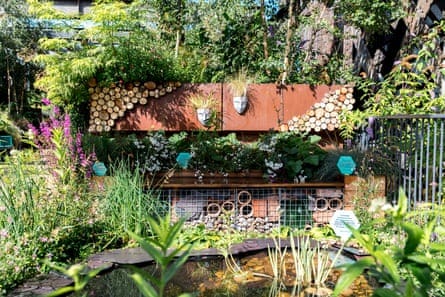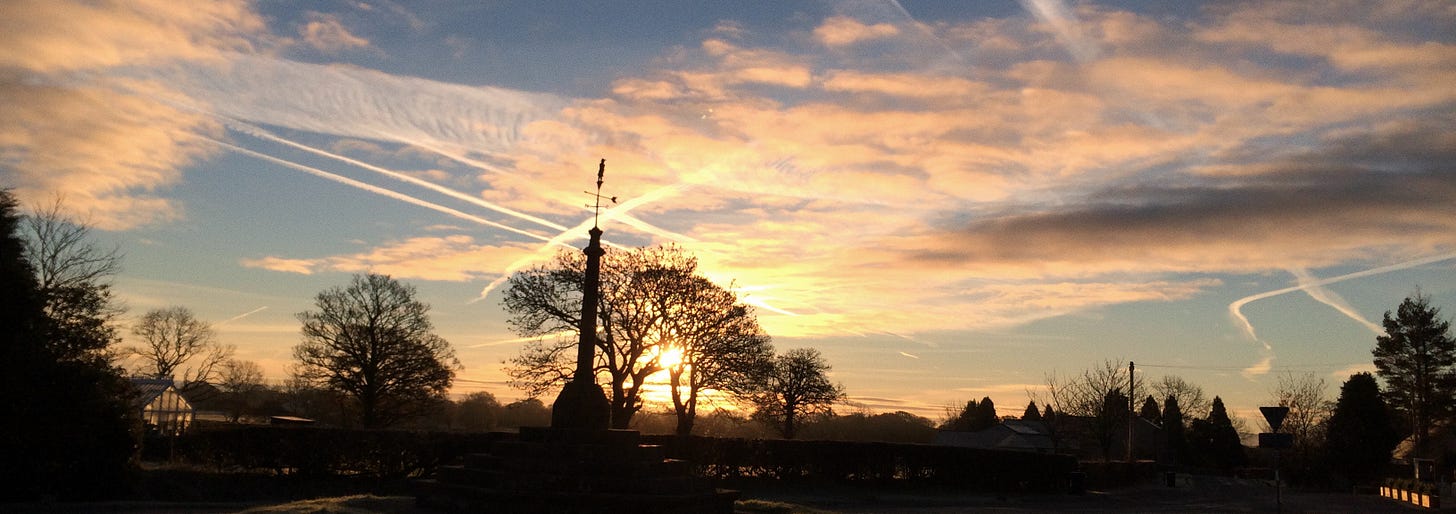Positive. Potential. Possible.
urban greening projects, cycling infrastructure, forest schools, botanizing, undisturbed grassland fungi, wintering well ... and Zoom Regenerative reaches 60.
Thank you for choosing to read Regen Notes
Regenerative entails focusing on potentials, positivities and possibilities, of asking different questions to scale emerging possibilities. To paraphrase Denis Hayes, once something is happening, we can no longer call it impossible. Looking through the cracks of the climate news, there are wonderful glimmers of light on possibilities. It is through these cracks that the light will get through. So here is a roundup and celebration of positives that have crossed my feeds in the last few weeks.
This newsletter celebrates the emergence of regenerative innovations that reconnect people with nature in cities, provide sustainable transportation, engage children with outdoor learning, protect biodiversity, and enhance wellbeing. From urban greening projects and cycling infrastructure to forest schools and undisturbed grasslands harboring rare fungi, it highlights fresh possibilities for creating abundance, health, and joy through designs that celebrate our kinship with the living world and winter light. Small steps like reimagining parks and play spaces can ripple out to transform cities into centers of ecological vitality.
Giving city dwellers access to nature is key aim
Bringing glorious gardens and green space to nature-deprived people in cities is one of the National Trust’s most important roles.
The charity is aiming to bring its gardens to urban areas to increase access to nature, with an urban garden planned for the Chelsea flower show that will model a pocket park that can be copied and rolled out across towns and cities.
The National Trust director general, Hilary McGrady: “We know, just as our founders did, that access to nature and green space matters to people. It’s good for our well-being, our pride of place, climate resilience and of course for nature’s recovery. Yet far too many people are deprived of its benefits. That’s why the trust is working with partners to invest in urban green space, and calling on others, including the government, to do the same.”

A new green spine through the Canary Wharf estate
Glenn Howells Architects will masterplan a new green spine through the Canary Wharf estate, adding parks, gardens, waterside access, performance spaces, bridges, boardwalks and pontoons. It comes as Canary Wharf Group looks to diversify an area best known for having skyscrapers and the offices of major financial companies.
The group said the wharf would soon be open to paddleboarding, open water swimming and kayaking, adding that the area’s landscape would be ‘the first of its kind’ and ‘a model of how biodiversity can thrive in urban environments’.
Why Botanizing Can Make Our Lives Better
Botanizing is spending time alongside plants in order to observe and appreciate them as living organisms – like birding, but with subjects that stay in place. When you botanize, a simple walk in the woods becomes an immersive experience shared with many species. Getting to know your nonhuman neighbours is a way to engage with a changing planet.
Research has shown the value of being outside in natural green areas or around plants indoors. Even traditional western doctors are starting to prescribe nature walks to reduce stress and improve physical well-being. Botanizing can provide a reason to get outdoors, and spending time closely observing plants’ minute structures is a great mindfulness practice.
We also see botanizing as a valuable alternative to spending time on social media. As many experts have observed, online platforms have become so individually tailored by algorithms that each user participates in their own version of reality, a trend that has enabled increasingly combative and antisocial behavior. Botanizing is an opportunity to take a break from these tailored worlds and deeply engage with local human and nonhuman communities.
How forest schools boost children’s immune systems
We talk about bringing nature into our buildings - how about taking our building functions out into nature … At a Helsinki nursery, children spend all day in the forest. Erika Benke explores how outdoor learning benefits children’s health and teaches them to value nature.
Throughout the year, on Monday, Tuesday and Wednesday mornings, the Samoojat group of 21 children aged three to five trek for up to 40 minutes in the forest to get to their base camp. They spend seven hours outdoors, eating lunch in an open shelter and taking a nap in a tent before walking back to the nursery mid-afternoon.
A wealth of studies have shown that spending time in natural spaces has many health and psychological benefits for children, such as reduced obesity, improved mental wellbeing, increased resilience and faster cognitive development. It can also encourage the development of environmentally conscious behaviour by fostering an appreciation and respect for the natural world.
A notable aspect of cognitive development among children who take part in outdoor learning is a sense of responsibility towards local spaces.
The EU new declaration on cycling
Imagine a form of transport that’s accessible, requires no fuel, generates zero greenhouse gas emissions, improves your health and can be used in car-free neighbourhoods. Welcome to the humble bicycle.
Hailed by some as the EU’s most ambitious cycling initiative to date, it aims to “unleash the full potential of cycling in the European Union” with dedicated new funding and policy support to promote bike use and the bloc’s cycling industry.
Inglewhite Green Fungi
Closer to home (about 10 meters from my front door), our Village Green has been recently surveyed by ecologists on account of the number of waxcap species present (Blackening, Butter, Glutinous, Golden, Heath, Honey, Meadow, Parrot, Scarlet Slimy and Spangle waxcaps along with Deceiver, Earthball, Earthy Powercap, Pinkgill Entoloma, Yellow Club fungi and the rare Matt Fanvault (Camarophyllopsis shulzeri) which if confirmed would enable the green to be a Biological Heritage Site
The ecologist mentioned that the waxcaps only survive on grassland that has not been fertilised for up to 500 years. (Roughly the time of Henry 8th and the Spanish Armada)
Waxcap fungi are commonly found in grasslands and meadows, but they do need very specific conditions to thrive. Known for their ecological importance, they are sadly becoming rare. They form partnerships with plants, where they exchange nutrients with the roots of host plants, benefiting both the fungi and other plants. This only happens in habitats with a high level of biodiversity with well-drained soil, on land that has not been disturbed by farming equipment, has not been fertilised for a very long time, is low in soil nutrients, with short grass and plenty of mosses.
Waxcap fungi are fascinating not only for their vibrant colours but also for their significance as indicators of healthy, biodiverse environments.

Wondering where in the world Inglewhite Green is? ... check out the location of the Village Cross that dates from 1500 on What Three Words ///daunted.failed.reported
Hemplime products are a superfood for the building industry ’
HempLime products are a superfood for the building industry. Products made from hemp and lime offer healthier alternatives in insulation, wall systems, textiles, and more because they do not contain harmful petrochemicals. Both hemp and lime absorb carbon dioxide from the atmosphere, and hemp plants also regenerate depleted soils while they grow. Health Materials Lab
Trees will be at the heart of future urban planning.
Experts predict that "forest lungs" will be created, thanks to an increased understanding of the benefits of trees for society. They say there will likely be a greater blurring of boundaries between urban and rural areas, with an increase in green infrastructure and connectivity.
International commitments around nature are also likely to have repercussions at the local level. For example, the mandatory reporting of companies' supply chain impacts on nature, such as through the new framework being developed by the Taskforce on Nature-related Financial Disclosures (TNFD), could create additional incentives for nature-friendly forest management.”
Wintering Well - Light is a Right
A wonderful podcast from BBC Scotland Out of Doors focused on the Wintering Well programme in Scotland that addresses SAD - Seasonal Affective Disorder. Take a listen, and check out their toolkit for Wintering Well Together.
And, timely for this season, between Samhain and Midwinter, an extract from one of the wonderful poems from their ebook - Light is a Right
Light in a right!
we want our warm-arse benches!
Light in a right!
we want our sit ooteries and star-gazer recliners!
Light in a right!
we want our streets lined with SAD lamps and sunflowers!
Light in a right!
we want high places, long views, and far horizons!
Light in a right!
we want guerrilla plantings, urban crofts, and glamourous night buses!
Light in a right!
we want their fire, and their fire, and their fire, to be our fire!
Light in a right!
because, Winter, you make the frost bite, the colours vibrate, and force us to feel intensely!Zoom Regenerative 60
Zoom Regenerative reaches its 60th episode and continues with the healthy, nature positive theme with Justin Eade sharing insights from his work on healthier places, happier people and aging well on the 21st November at 8pm UK
"It has always been a radical act to tell stories during dark times. They are the regenerative spaces of creation and renewal. As we experience a loss of connection to the Earth we share stories that explore the timeless connections between ecology, culture and spirituality." Text from from Emergence Magazine that helped bring Zoom Regenerative into being 60 episodes ago, back in 2020





